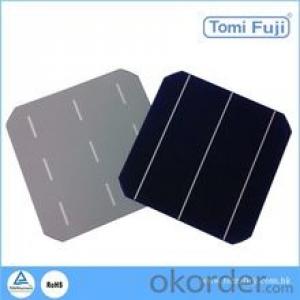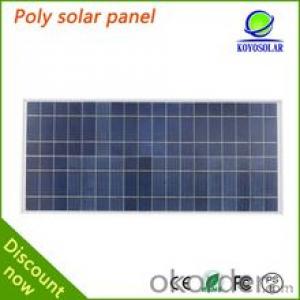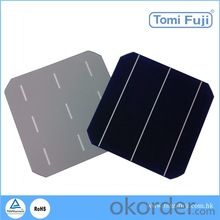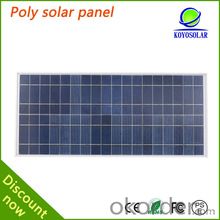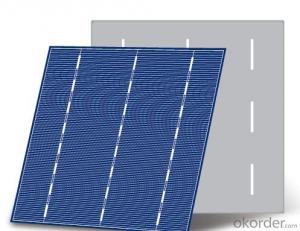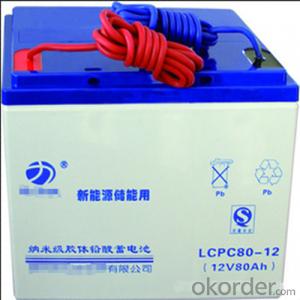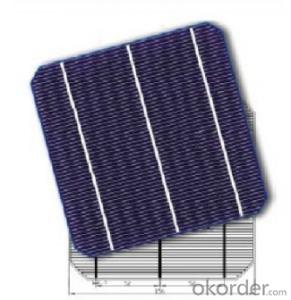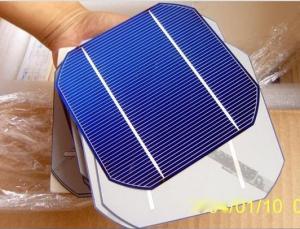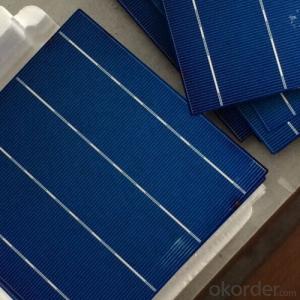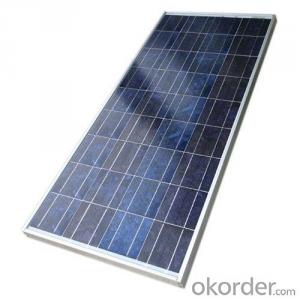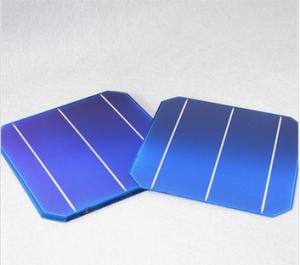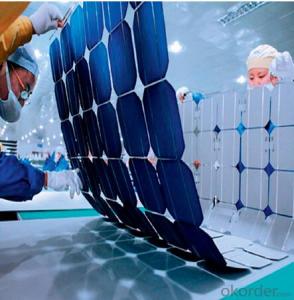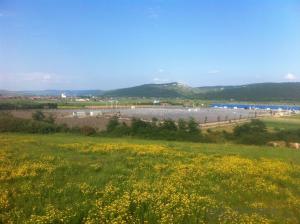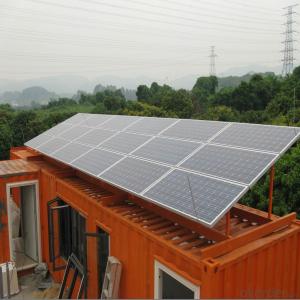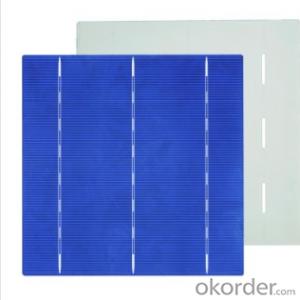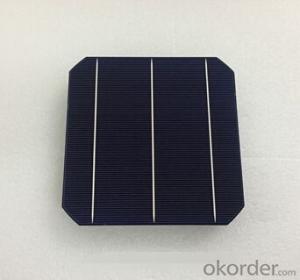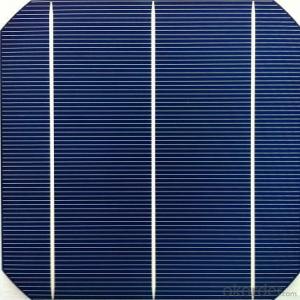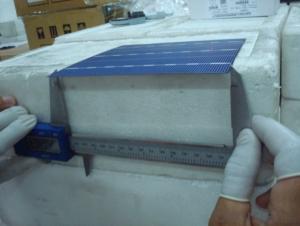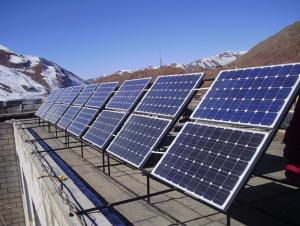Flexible Solar Cells for Clothing - A Grade Certified Solar Cell Mono/Poly Crystalline 156mm CNBM
- Loading Port:
- Qingdao
- Payment Terms:
- TT or LC
- Min Order Qty:
- 100 set
- Supply Capability:
- 300000 set/month
OKorder Service Pledge
OKorder Financial Service
You Might Also Like
Quick Details
| Place of Origin: | China (Mainland) | Brand Name: | cnbm | Model Number: | T1M-1780 |
| Material: | Polycrystalline Silicon | Size: | 156*156mm | Number of Cells: | 1pcs |
| Max. Power: | 4.4watt | Size:: | 156*156mm | Material:: | Polycrystalline Silicon |
| Materials:: | poly cell, broken solar cells for sale | Certificate:: | ISO9001,CE/TUV | solar cell:: | poly solar cell,broken solar cells for sale |
| Front side:: | Two/three 1.9/1.6mm wide silver bus ba | Tickness:: | 200μm±30μm | OEM Order:: | Acceptable |
| Back side:: | 3mm wide silver soldering pads |
Packaging & Delivery
| Packaging Detail: | 100pcs in one carton, one carton gross weight is about 2kg |
| Delivery Detail: | 1days after your paymen |
mono/polycrystalline solar cell
1.16.8%~18.25% efficiency
2.100% good quality
3.ISO9001/ISO14001/TUV/CE/UL
4. A grade cell
solar cell All Your Best Choice

| Physical Characteristics of broken solar cells for sale | ||||||||||||
| Dimension: | 156mm×156mm±0.5mm | |||||||||||
| Diagonal: | 220mm±0.5mm | |||||||||||
| Thickness(Si): | 200±20 μm | |||||||||||
| Front(-) | anti-reflecting coating (silicon nitride); | |||||||||||
| 1.5mm wide bus bars; | ||||||||||||
| Distance between bus bars: 51mm . | ||||||||||||
| Back(+) | Aluminum back surface field; | |||||||||||
| 2.0mm wide soldering pads; | ||||||||||||
| Distance between bus bars :51mm . | ||||||||||||
| Electrical Characteristics of broken solar cells for sale | ||||||||||||
| Efficiency(%) | 18 | 17.8 | 17.6 | 17.4 | 17.2 | 16.8 | 16.6 | 16.4 | 16.2 | 16 | 15.8 | 15.6 |
| Pmpp(W) | 4.33 | 4.29 | 4.24 | 4.19 | 4.14 | 4.09 | 4.04 | 3.99 | 3.94 | 3.9 | 3.86 | 3.82 |
| Umpp(V) | 0.53 | 0.527 | 0.524 | 0.521 | 0.518 | 0.516 | 0.514 | 0.511 | 0.509 | 0.506 | 0.503 | 0.501 |
| Impp(A) | 8.159 | 8.126 | 8.081 | 8.035 | 7.99 | 7.938 | 7.876 | 7.813 | 7.754 | 7.698 | 7.642 | 7.586 |
| Uoc(V) | 0.633 | 0.631 | 0.628 | 0.625 | 0.623 | 0.62 | 0.618 | 0.617 | 0.615 | 0.613 | 0.611 | 0.609 |
| Isc(A) | 8.709 | 8.677 | 8.629 | 8.578 | 8.531 | 8.478 | 8.419 | 8.356 | 8.289 | 8.22 | 8.151 | 8.083 |

Monocrystalline 125/156mm and polycyrstalline156 solar cell more pictures:
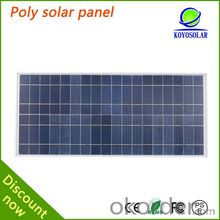
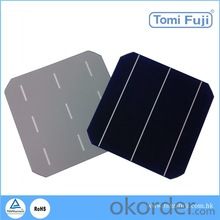
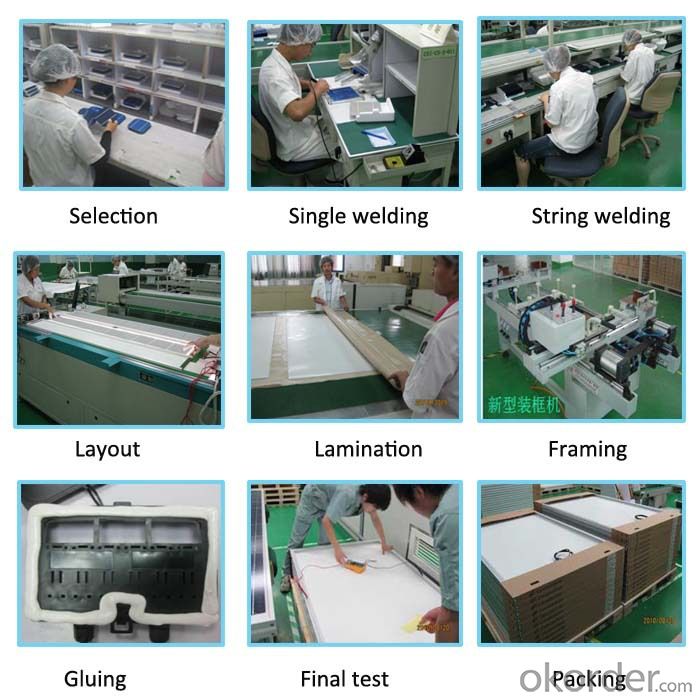
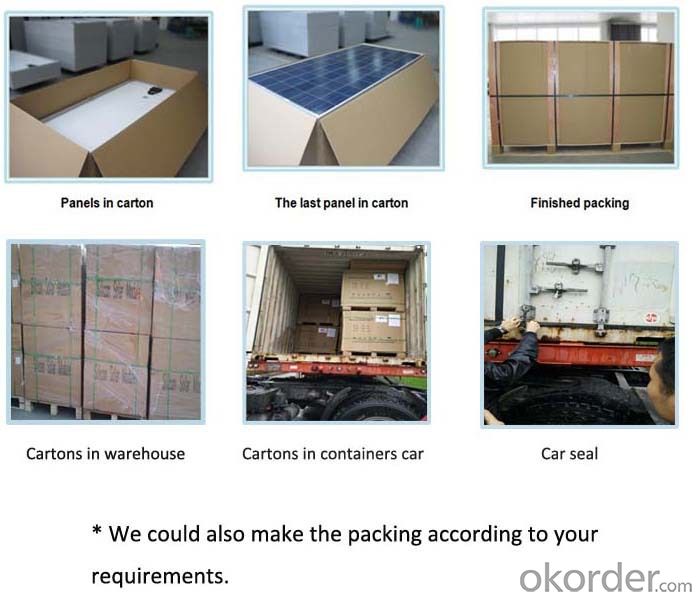
Packaging
u 100pcs/ctn, one carton is about 2kg.
u Individual packing requirement is acceptable.
By Sea | Delivery from Shanghai or Ningbo seaport |
By Air | Departure from Shanghai Pudong Airport |
By Express | Post by DHL, EMS, UPS, TNT. |
Although solar cells surplus, consumption tends to be active
All along, China's solar cell industry is facing surplus. Thus, the solar cell industry needs contact with the related industries closely, in order to open up a wide range of consumer markets.
Integration of cross-border trade, cross-border products will become a new trend in the production of solar energy industry. Solar power technology and consumer products combine more flexible.
Although solar cells are surplus, faced with increasingly serious energy crisis and air pollution, solar PV is becoming the mainstream in the form of new energy sources. With more perfect industry chain, solar energy products consumption has not only limited to large-scale power, and become more diverse. Gradually open up the domestic market and jump start the market, so that once plagued the Chinese PV industry began to pick up.
Solar cell industry has demonstrated a new application. With the use of new technology and declining costs, increasing the degree of market segmentation, the combine of solar technology and civil products is full of vitality. Integration of cross-border trade, cross-border products will become a new trend in the production of solar energy industry.
Currently, the national multi-sectoral support policies are still intensive introduction. Driven by the favorable policies, gradually increase the spending power of the solar cell. At the same time, the export structure of the solar cells are also more reasonable state, especially in Asian emerging markets continue to expand.
This year, with the decline in the cost of electricity, continued growth in overall industry demand and increasingly rational investment, coupled with smart grid construction, and constantly open up new markets effectively promote PV production capacity has expanded capacity utilization will also increase steadily. Forced downward pressure on the cost of power generation, high efficiency, the new demand for low-cost photovoltaic cell products will continue to grow in the future; it has also become the focus of the major manufacturers of photovoltaic production layout.
- Q: What are the advantages and disadvantages of solar panels and diodes?
- I first connected to a positive and negative, and then in the positive series more than one, is not it can be achieved to prevent short circuit, to prevent the return can also play a rectifier 3 role?
- Q: Can solar cells be used in military vehicles?
- Yes, solar cells can be used in military vehicles. They can provide an alternative source of energy to power various systems and equipment, reducing reliance on traditional fuel sources and enabling greater operational flexibility and sustainability. Additionally, solar cells can help extend the range and endurance of military vehicles in remote or austere environments where access to conventional fuel supplies may be limited.
- Q: Can solar cells be used to power electric vehicle charging stations?
- Yes, solar cells can be used to power electric vehicle charging stations. Solar panels can generate electricity from sunlight, which can be stored in batteries or directly used to charge electric vehicles. This renewable energy source can reduce reliance on the grid and contribute to a more sustainable and environmentally-friendly charging infrastructure.
- Q: What is the cost of solar cells?
- The cost of solar cells varies depending on a variety of factors such as the type and size of the solar cell, installation costs, and government incentives. On average, the cost can range from $0.30 to $0.60 per watt for residential solar cells and can be higher for commercial or utility-scale installations. It's important to consider the long-term benefits and savings that solar cells provide, making them a cost-effective investment in renewable energy.
- Q: How do solar cells handle electromagnetic fields from power lines?
- Solar cells are designed to convert sunlight into electricity, and they do not have the ability to handle or interact with electromagnetic fields from power lines.
- Q: How do solar cells perform in different climates?
- Solar cells can perform well in various climates, although their efficiency may vary. In regions with abundant sunlight and higher temperatures, solar cells can generate more electricity. However, extreme heat can slightly reduce their efficiency. In colder climates, solar cells can still produce electricity, although their output may be lower during winter months due to reduced sunlight. Overall, solar cells can function effectively in different climates, but the specific performance may depend on the local weather conditions.
- Q: Can solar cells be used in space?
- Yes, solar cells can be used in space. In fact, they are commonly used in space missions to generate electricity from the sunlight in the absence of an atmosphere. Spacecraft and satellites often rely on solar cells to power their systems and equipment.
- Q: Can solar cells be used for powering remote medical clinics?
- Yes, solar cells can be used for powering remote medical clinics. Solar energy is a reliable and sustainable source of power, particularly in areas where access to the electricity grid is limited. By installing solar panels, remote medical clinics can generate their own electricity, ensuring a continuous power supply for essential medical equipment, lighting, refrigeration, and other critical healthcare needs. This enables the provision of quality healthcare services in remote areas without relying on traditional energy sources.
- Q: How do solar cells perform in areas with frequent hurricanes?
- Solar cells can still perform well in areas with frequent hurricanes, provided they are designed and installed with specific considerations in mind. Reinforced mounting systems, robust construction materials, and proper installation techniques can enhance the durability of solar panels against strong winds and debris. Additionally, grid-connected solar systems with battery storage can provide reliable power during power outages caused by hurricanes, making them a resilient energy solution for such areas.
- Q: How do solar cells handle snow or ice accumulation?
- Solar cells can handle snow or ice accumulation by either melting the snow or ice due to their ability to absorb sunlight and convert it into electricity, or by allowing the snow or ice to slide off the surface due to their smooth and slippery design. Additionally, some solar panels are tilted at an angle, which helps prevent snow or ice buildup by allowing it to slide off more easily.
Send your message to us
Flexible Solar Cells for Clothing - A Grade Certified Solar Cell Mono/Poly Crystalline 156mm CNBM
- Loading Port:
- Qingdao
- Payment Terms:
- TT or LC
- Min Order Qty:
- 100 set
- Supply Capability:
- 300000 set/month
OKorder Service Pledge
OKorder Financial Service
Similar products
Hot products
Hot Searches
Related keywords
